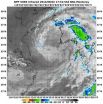(Press-News.org) The low pressure area known as System 96W struggled to organize for a week and finally became Tropical Storm Nakri on August 2 as the Suomi NPP satellite passed overhead. Nakri had a short life, however, as it dissipated the following day while approaching South Korea.
On Saturday, August 2, at 9 p.m. EDT, Nakri's maximum sustained winds were near 40 knots (46 mph/74 kph). At that time it was centered about 100 nautical miles southeast of Kunsan Air Base, near 35.0 north and 125.0 east. It was moving to the north at 14 knots (16.1 mph/21.9 kph).
When NASA-NOAA's Suomi NPP satellite passed over Nakri on August 2, the Visible Infrared Imaging Radiometer Suite (VIIRS) instrument aboard captured an infrared image of the storm. The VIIRS instrument showed a tightly wrapped center with fragmented bands of thunderstorms wrapping into the center. VIIRS also showed the heaviest precipitation was falling east of the center of circulation.
VIIRS collects visible and infrared imagery and global observations of land, atmosphere, cryosphere and oceans. VIIRS flies aboard the Suomi NPP satellite, which is managed by both NASA and NOAA.
By 1900 UTC (5 p.m. EDT) on August 3, the Joint Typhoon Warning Center issued its final advisory on Nakri. By that time, Nakri had already weakened to a tropical depression. It was centered near 36.1 north and 125.8 east, about 15 nautical miles (17.2 miles/27.8 km) northwest of Kunsan Air Base. Later on August 3, Nakri dissipated on approach to the Korean peninsula.
INFORMATION:
Text credit: Rob Gutro
NASA's Goddard Space Flight Center
NASA catches the brief life of Tropical Storm Nakri
2014-08-04
ELSE PRESS RELEASES FROM THIS DATE:
NASA sees Typhoon Halong's eye wink
2014-08-04
As Super Typhoon Halong tracks north through the Northwestern Pacific Ocean, NASA's Aqua and Terra satellites have seen the powerful storm appear to wink at space as it developed and "opened" an eye and then close its eye as clouds moved over it. That wink appears to be a sign of eyewall replacement in the powerful storm.
On August 2 at 01:45 UTC (August 1 at 9:45 p.m. EDT) NASA's Terra satellite captured a visible image of a wide-eyed Super Typhoon Halong moving through the Northwestern Pacific Ocean. At the time of the image, Halong was a powerful Category 5 Super Typhoon ...
No-power Wi-Fi connectivity could fuel internet of things reality
2014-08-04
Imagine a world in which your wristwatch or other wearable device communicates directly with your online profiles, storing information about your daily activities where you can best access it – all without requiring batteries. Or, battery-free sensors embedded around your home could track minute-by-minute temperature changes and send that information to your thermostat to help conserve energy.
This not-so-distant "Internet of Things" reality would extend connectivity to perhaps billions of devices. Sensors could be embedded in everyday objects to help monitor and track ...
NASA's IBEX and Voyager spacecraft drive advances in outer heliosphere research
2014-08-04
San Antonio -- Aug. 4, 2014 -- Scientists yesterday highlighted an impressive list of achievements in researching the outer heliosphere at the 40th International Committee on Space Research (COSPAR) Scientific Assembly in Moscow.
"Between NASA's Voyager and IBEX missions, it's an incredible time for outer heliospheric science," says Dr. Dave McComas, IBEX principal investigator and assistant vice president of the Space Science and Engineering Division at Southwest Research Institute, who also will be recognized with a 2014 COSPAR Space Science Award at the assembly. "Ten ...
Children in immigrant families more likely to be sedentary
2014-08-04
Immigrant children from all racial and ethnic backgrounds are more likely to be sedentary than U.S.-born white children, according to a new study by sociologists at Rice University. The researchers said their findings should remind pediatricians and parents of children in immigrant families to encourage physical activity.
The research revealed that children of immigrants from all racial and ethnic backgrounds have lower levels of physical activity than U.S.-born white children, even when adjustments are made for socio-demographic and neighborhood characteristics. A low ...
New tools advance bio-logic
2014-08-04
Researchers at Rice University and the University of Kansas Medical Center are making genetic circuits that can perform more complex tasks by swapping protein building blocks.
The modular genetic circuits engineered from parts of otherwise unrelated bacterial genomes can be set up to handle multiple chemical inputs simultaneously with a minimum of interference from their neighbors.
The work reported in the American Chemical Society journal ACS Synthetic Biology gives scientists more options as they design synthetic cells for specific tasks, such as the production of ...
GW researcher reveals how amphibians crossed continents
2014-08-04
There are more than 7,000 known species of amphibians that can be found in nearly every type of ecosystem on six continents. But there have been few attempts to understand exactly when and how frogs, toads, salamanders and caecilians have moved across the planet throughout time.
Armed with DNA sequence data, Alex Pyron, an assistant professor of biology at the George Washington University, sought to accurately piece together the 300-million-year storyline of their journey.
Dr. Pyron has succeeded in constructing a first-of-its-kind comprehensive diagram of the geographic ...
How should flood risk assessments be done in a changing climate?
2014-08-04
Growing consensus on climate and land use change means that it is reasonable to assume, at the very least, that flood levels in a region may change. Then why, ask Rosner et al. in a new study, do the dominant risk assessment techniques used to decide whether to build new flood protection infrastructure nearly always start with an assumption of "no trend" in flood behavior?
In an argument grounded in an analysis of the inherent limitations of statistical analyses, the authors suggest that researchers' typical starting assumption that flood behavior is not changing—even ...
Insights on whale shark populations and evidence for their historic rise and recent decline
2014-08-04
In the largest study on the genetics of whale sharks conducted to date, researchers found that the world's biggest fish likely exist in 2 distinct populations with minimal connectivity between the Indo-Pacific and the Atlantic Ocean. The findings suggest that mixing of whale sharks between the Indian and Atlantic was and is rare.
The Molecular Ecology investigators also found a significant and likely recent population expansion, but a very recent bottleneck might have gone undetected as genetic diversity at Ningaloo Reef in Australia has declined during 5 consecutive ...
Study assesses shark attacks on Atlantic spotted dolphins near the Bahamas
2014-08-04
A Marine Mammal Science analysis on failed shark attacks on the approximately 120 Atlantic spotted dolphins that are residents of the waters near Bimini, The Bahamas, has found that a total of 14 dolphins (15% of 92 cataloged animals) showed some sign of shark attack, and a further 15 (16%) exhibited scars that could not conclusively be classified as shark induced or not.
Of 14 the shark attacks, there was no difference in scars or wounds between the sexes, and there was no significant difference between the location of bodily scars and wounds. No shark-related injuries ...
Humane strategy reduces shark attacks
2014-08-04
A simple and humane technique may be an effective strategy to reduce human encounters with sharks without harming populations of threatened shark species.
Instead of using advanced (and relatively untested) technology to attempt to repel sharks or nondiscriminatory nets that kill other threatened sea life as bycatch, researchers have simply caught sharks and moved them to where they would not pose a threat to swimmers. The Shark Monitoring Program of Recife, Brazil, reported approximately 100% survival of protected species and a 97% decrease in shark attacks when the ...





